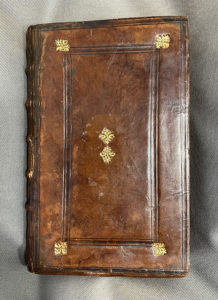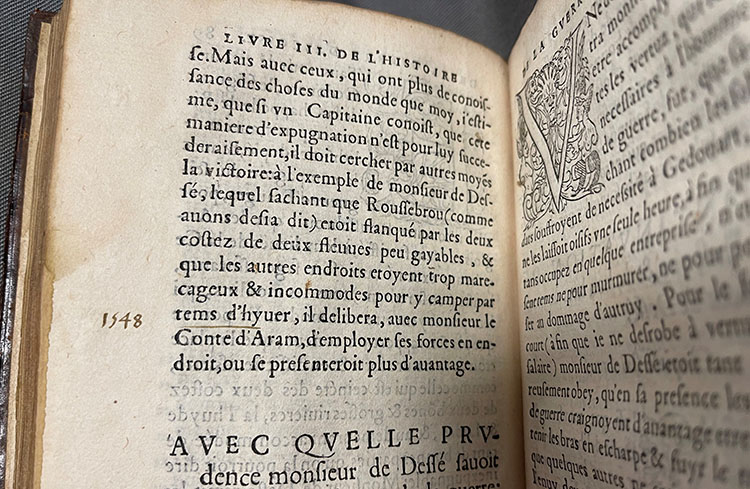Scotland and France: an ‘Auld Alliance’ of two equals?
We are delighted that students on Dr Amy Blakeway’s ‘Mary Queen of Scots, France, England and Ireland’ module (MO4807) have once again submitted blog posts as part of their course. Here is the first in a small series of blogs which reflect on the rare books with which the students engaged during their studies.

L’histoire de la gverre d’Escosse (TypFP.B56BG) has provided historians with a detailed account of the final years of the ‘Rough Wooings’ (fought between the ‘auld enemies’ over the marriage of Mary Queen of Scots) in Scotland from a French perspective. Its author was French soldier Jean de Beaugué, who was active in these campaigns and published this work in Paris in 1556. One of the forty-nine surviving copies is held in the University Collections and survives in remarkably good condition. The spine has been repaired more recently but the contemporary binding remains intact and provides evidence of the book’s symbolic purpose as a token of French military prowess. Golden fleurs-de-lis embellish the front and back, clearly reflecting French monarchical grandeur and the success of the French in this particular campaign.

However, despite the confident binding, in 1556 France was facing a period of political uncertainty. Henry II had established a truce with the Holy Roman Empire which involved the captivity of the French nobleman François de Montmorency, to whom Beaugué dedicated the book. The truce was fragile and anxieties concerning French military strength were consequently exacerbated. Beaugué’s production of L’histoire helped to mitigate these fears by illustrating French military success through historical escapism.

The book itself was not produced for ornamental purposes, rather its small size and clear print indicate it was made for wide dissemination and engagement amongst a literate French audience. The contemporary owner of this particular copy has engaged with the text by adding their own marginal annotations which denote specific dates, and by underlining a few words concerned with the seasonal effects in Scotland – perhaps this continental reader was shocked by the dreich Scottish climate!


Clearly undeterred by the weather, French interest in Scotland continued during the mid-sixteenth century and this book illustrates the political importance of Scotland from the perspective of the French during this period. As ‘Protector’ of Scotland, Henry II had the power to appoint Mary of Guise as regent in 1553. Guise herself therefore symbolized the extension of French authority in Scotland and the success of France’s international diplomacy at the time. Beaugué highlights this by emphasising her ‘most winning Behaviour’ and ‘Proofs of Her Kindness’ to such an extent that he apologetically proclaimed ‘I hope, I shall not weary my Reader’.
French authority was also subtly portrayed by Beaugué through his stigmatisation of the Scots. He challenged the civility of the Scottish soldiers who mutilated the faces of their deceased enemies; arguing that the French would not behave in this manner ‘for charm’d with their Civility, and pleas’d with their Valour, they express’d on all Occasions a Sense of Favour and Esteem for them.’ He enhanced this narrative by distinguishing the Highlanders as ‘almost naked’ and adorning ‘Painted Waist-Coats’ and ‘a sort of Woollen Covering’, thereby adopting the traditional stereotyping of Highland culture – illustrated in François Desprez’s, Recueil de la diversité des habits, for example.
Image taken from François Desprez, Recueil de la diversité des habits (Paris, 1567), 22r. Source gallica.bnf.fr/BnF.
L’histoire therefore reveals French understandings of the power dynamic between Scotland and France during the mid-sixteenth century, whilst symbolising the importance of the Auld Alliance from a French political perspective. Even so, the existence and survival this book offers evidence of the value that the French held for their relationship with Scotland.
Georgia Ringham
Class of 2021-2022
Bibliography
Primary
Beaugué, Jean de, L’histoire de la gverre d’Escosse : traitant comme le royaume fut assailly, & en grãd’ partie occupé par les Anglois, & depuis rendu paisible à sa reyne, & reduit en son ancien estat & dignité (Paris, 1556), copy in St Andrews, University of St Andrews Library, Special Collections Rare Books, TypFP.B56GB.
Beaugué, Jean de, The history of the campagnes 1548 to 1549, ed. and trans. Patrick Abercromby (1707).
Desprez, François, Recueil de la diversité des habits (Paris, 1567).
Secondary
Baumgartner, Frederic J., Henry II: King of France 1547-1559 (London, 1988).
Fenwick, Hubert, The Auld Alliance (Kineton, 1971).
Macdougall, Norman, An Antidote to the English: The Auld Alliance, 1295-1560 (East Linton, 2001).
Merriman, Marcus, The Rough Wooings: Mary Queen of Scots, 1542-1551 (East Linton, 2000).
Ritchie, Pamela E., Mary of Guise in Scotland, 1548-1560: A Political Career (East Lothian, 2002).
